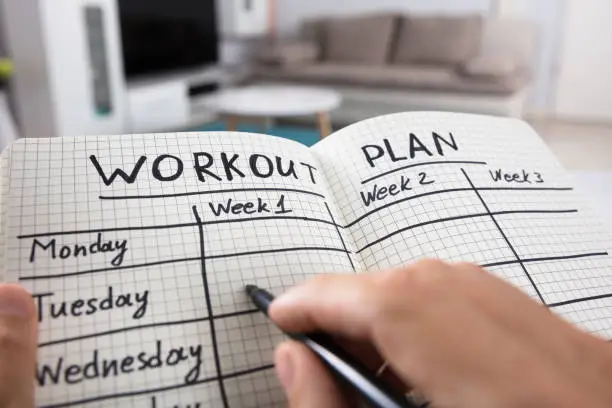Introduction
When it comes to fitness goals, many people focus on either losing weight or building muscle. What if you could achieve both goals simultaneously? That’s the concept behind body recomposition workout. Body recomposition refers to the process of simultaneously building muscle and losing fat, resulting in a leaner, stronger physique.
In this article, we’ll explore the science behind body recomposition, the best workouts to achieve it, and how to adjust your nutrition to support your efforts. Whether you’re a beginner or an experienced gym-goer, body recomposition is an effective approach for transforming your physique.
What Is Body Recomposition?
Body recomposition involves altering the balance between fat and muscle in your body. This involves reducing body fat while increasing lean muscle mass. Unlike traditional weight loss, where the goal is purely to reduce the number on the scale, body recomposition focuses on improving body composition. As a result, you may not notice a dramatic change in your overall weight, but your body will become more toned, defined, and healthier.
Why Focus on Body Composition Instead of Weight?
The number on the scale isn’t always an accurate measure of your overall health. Two individuals might have the same weight, but their body compositions can be significantly different. One person might have more muscle mass, while the other might have a higher percentage of body fat. By focusing on body recomposition, you can achieve a leaner and stronger physique, even if your weight remains relatively stable.

The Science Behind Body Recomposition
To understand how body recomposition works, it’s important to look at how the body builds muscle and burns fat.
- Building Muscle: Muscle growth, or hypertrophy, occurs when you engage in resistance training exercises that cause microscopic tears in your muscle fibers. As these tears heal, the muscles grow back stronger and larger.
- Burning Fat: Fat loss happens when you create a caloric deficit, meaning you burn more calories than you consume. This forces the body to use stored fat as energy, leading to a reduction in fat mass.
The challenge with body recomposition is that building muscle typically requires a caloric surplus, while burning fat requires a caloric deficit. However, with the right workout and nutrition plan, it is possible to balance these processes and achieve both goals.
Best Workouts for Body Recomposition
Achieving body recomposition requires a well-rounded workout routine that combines both resistance training and cardio. Here are the top types of workouts to include in your plan:
1. Strength Training
Strength training is the cornerstone of any body recomposition workout. Exercises like squats, deadlifts, bench presses, and pull-ups work multiple muscle groups, helping you build lean muscle mass. Aim for compound movements, which target more than one muscle group at a time, for maximum efficiency.
2. High-Intensity Interval Training (HIIT)
HIIT consists of alternating between brief bursts of high-intensity activity and intervals of rest or low-intensity exercise. HIIT is highly effective for burning fat while preserving muscle mass. A typical HIIT session could include sprints, jump squats, or burpees.

3. Resistance Circuit Training
In resistance circuit training, you perform a series of strength-training exercises with minimal rest between sets. This keeps your heart rate elevated, promoting fat loss while still engaging your muscles.
4. Cardio Workouts
Cardio is essential for creating a caloric deficit and promoting fat loss. Incorporate both steady-state cardio (such as jogging or cycling) and HIIT for optimal results. Cardio also improves heart health and overall endurance.
Structuring Your Body Recomposition Workout Plan
5. Bodyweight Exercises
Bodyweight exercises like push-ups, lunges, and planks are excellent for those who don’t have access to a gym. These exercises can be done anywhere and still promote muscle growth and fat loss.
Creating an effective workout plan for body recomposition involves balancing strength training and cardio. Here’s a sample weekly structure:
- Day 1: Full-body strength training (focus on compound movements)
- Day 2: HIIT workout (20-30 minutes)
- Day 3: Upper body strength training
- Day 4: Steady-state cardio (45 minutes)
- Day 5: Lower body strength training
- Day 6: Resistance circuit training or bodyweight exercises
- Day 7: Rest or engage in active recovery, such as light walking or stretching.

Nutrition for Body Recomposition
Exercise alone isn’t enough for body recomposition. Your diet plays a crucial role in supporting muscle growth while promoting fat loss. Here’s how to adjust your nutrition to align with your goals:
1. Protein Intake
Protein is essential for muscle repair and growth. Aim to consume 1.2 to 2 grams of protein per kilogram of body weight each day. Sources of high-quality protein include lean meats, eggs, fish, and plant-based options like lentils and tofu.
2. Manage Calories
To achieve body recomposition, you need to carefully manage your caloric intake. While it may seem counterintuitive, you don’t always need to be in a significant caloric deficit. Instead, aim for a slight deficit (around 300-500 calories below maintenance) to promote fat loss while supporting muscle growth.
3. Balance Macronutrients
In addition to protein, you need to ensure you’re consuming enough carbohydrates and fats to fuel your workouts and recovery. Focus on complex carbohydrates (like whole grains and vegetables) and healthy fats (such as avocados, nuts, and olive oil).
4. Nutrient Timing
When you eat can also impact your results. Try to consume protein and carbs after your workout to support muscle repair and replenish glycogen stores. This will enhance your recovery and help you achieve your goals more effectively.
The Role of Recovery in Body Recomposition
Recovery is often overlooked in workout plans, but it’s vital for body recomposition. When you’re aiming to both build muscle and lose fat, your body needs time to repair and recover. Here are some recovery tips:
1. Get Enough Sleep
Sleep is when your body repairs muscle tissue and burns fat. Strive to eat between 1.2 and 2 grams of protein per kilogram of body weight daily.
2. Stretching and Mobility
Include stretching and mobility exercises in your routine to reduce the risk of injury and enhance flexibility. This can also help reduce soreness after intense workouts.
3. Active Recovery
On rest days, engage in light physical activity like walking or yoga to promote blood flow and aid in muscle recovery.
How Long Does Body Recomposition Take?
Body recomposition is a slow and steady process. Unlike quick-fix diets, it can take several months to see significant changes in your physique. However, the results are more sustainable and healthier in the long term. Be patient and consistent with your workouts and nutrition, and you will gradually see your body transform.
Common Mistakes to Avoid
While body recomposition is an effective approach, there are some common mistakes that can hinder your progress:
1. Focusing Only on Cardio
Cardio is important, but strength training is essential for building muscle. Don’t neglect weightlifting in favor of excessive cardio.
2. Underestimating Protein Intake
Many people don’t eat enough protein to support muscle growth. Make sure you’re hitting your protein goals daily.
3. Not Tracking Progress
Keep track of your workouts, diet, and body composition changes. This will help you make adjustments and stay motivated as you progress.
Conclusion
Body recomposition is a powerful approach to achieving a leaner, stronger physique. By combining strength training, cardio, and a well-balanced nutrition plan, you can build muscle and burn fat simultaneously. Remember, consistency is key—stick with your plan, and you’ll start seeing results over time. With patience and dedication, body recomposition can help you reach your ultimate fitness goals.



